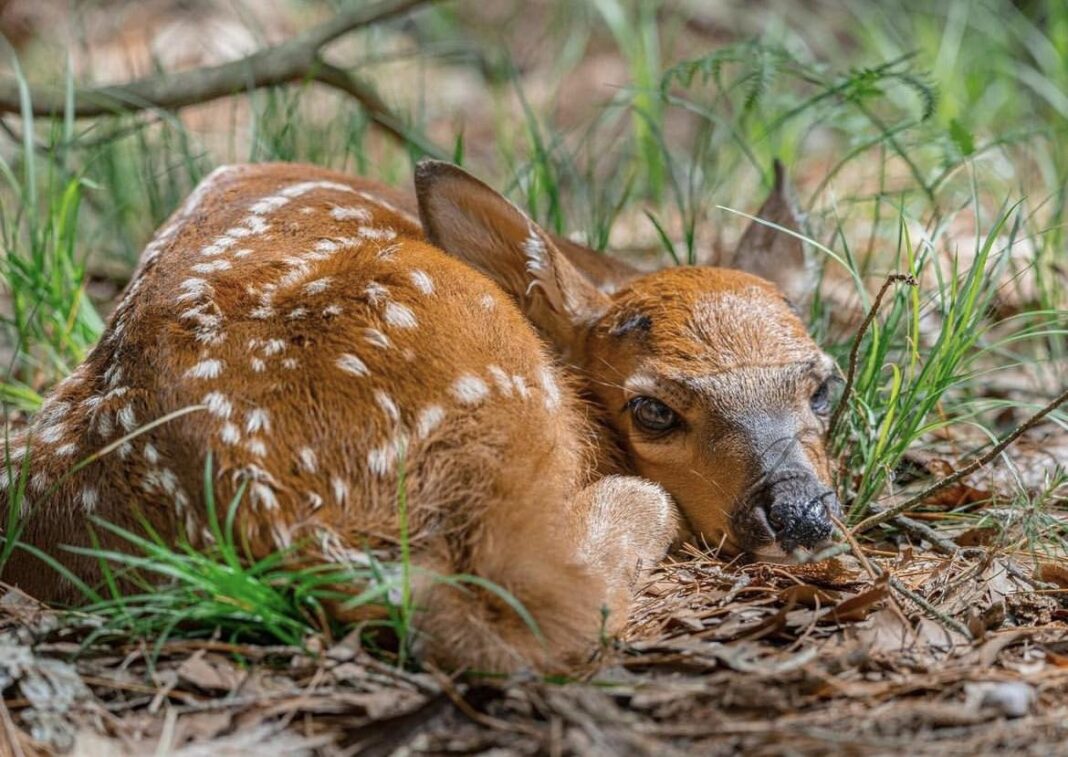Whitetail Fawn Growth and Adaptation: The First Steps of Life
Whitetail fawns experience rapid growth during the late spring and into the summer months. Fawns in the North are typically born in mid-May through June, while fawns in the Southern Hemisphere are born during a much wider time frame due to the huge breeding window. Healthy fawns will weigh between 4 to 8 pounds at birth, and then double that weight during the first 2 weeks of life, which is a period during which they survive entirely on their mothers’ milk. Beginning around 2 weeks of age, rumination begins in their stomach as they begin to supplement their milk diet with soft forages. Fawns will triple their birth weight within the first 3 weeks of life.
Whitetail fawns adapt and master the art of hiding within hours of life, their spotted reddish-brown coat is designed perfectly to blend flawlessly into forested and tall grassy environments. Even in the first days of life, fawns will nurse with momma and then move away from the doe to bed for the remainder of the day. This behavior removes mom’s scent from the fawn’s bedding and nursing site, leaving virtually no sign for predators to discover them.
All of this underscores the key importance of planning and providing quality whitetail habitat and a wide range of cover types for does and fawns during the spring and summer months. An abundance of diverse forages and natural browse will ensure high-quality milk and quality green food for fawns, as well as a wide range of diverse cover to hide them from larger predators. All of this greatly improves fawn survival rates, the health of the overall population, and, ultimately, the quality of your hunting opportunities.
Predator Management and Its Impact on Fawn Survival
Predation, particularly from coyotes, foxes, and bobcats, can have a significant impact on fawn survival rates, especially during the first few weeks of life when fawns are most vulnerable. While some predation is a natural part of ecosystem dynamics, excessive predation can tip the balance and hinder overall herd growth. In areas where predator populations are high, consider implementing a predator management plan. Studies from Mississippi State University’s Deer Lab reveal that targeted predator control can significantly improve fawn survival rates.
Importance of Proper Nutritional Intake for Fawn Development
Providing a rich and diverse diet for both the doe and the fawn can significantly impact the growth, health, and ultimate survival of the fawn. Nutrient-dense food sources are especially crucial during the late summer and early fall when fawns are weaned off milk and start depending on solid food entirely. At this stage, they require a diet high in protein to continue their rapid growth and to build fat reserves that will carry them through their first winter. Articles on The National Deer Alliance provide insights into the nutritional needs of whitetail deer and the importance of high-quality forage.
Making Your Land Fawn-Friendly
Creating a property that’s friendly to whitetail deer isn’t just about food. It also involves providing enough cover to protect fawns from predators and harsh weather conditions. Thick underbrush, tall grasses, and dense woods can offer the necessary shelter for fawns. For tips on how to create and manage a habitat that helps fawns thrive, refer to the wealth of information in our Habitat Management section.
The management and monitoring of whitetail deer populations can be a fulfilling endeavor, ensuring healthy fawns grow into strong adults. By understanding the biology of these amazing creatures and implementing sound habitat management practices, hunters play a crucial role in supporting the future of whitetail deer populations.



















![The Best Deer Camp Chili [VIDEO] Deer Chili Ingredients, Tomatoes, Chili Spices](/wp-content/uploads/2015/10/Deer-Chili-Deer-Camp-Recipe-218x150.jpg)
![How to Call Elk Early in the Season [VIDEO]](/wp-content/uploads/2016/08/byers003-218x150.jpg)




![Idiots Disturb Hunter: How Would You Have Handled It? [VIDEO]](/wp-content/uploads/2015/10/DSC00110-e1474487693878-100x70.jpg)
![Albino Buck Shocked to Shed His Antlers [VIDEO]](/wp-content/uploads/2015/10/AlbinoDeer-100x70.jpg)